




Introduction to Earth Moon and Sun System
The solar system consists of the Sun, the planets that circle around it, their satellites, dwarf planets, and too many other objects such as asteroids and comets. All of these items move, and we can see them. We can see the Sun rise in the east in the morning and set in the west in the evening. At different seasons of the year, we may see different stars in the sky.
In 1543, Nicolaus Copernicus suggested a theory according to which the other planets and the Earth revolved around the Sun on a regular basis.
What is Moon, Earth and Sun?
The Earth is the planet on which we live. It is round, like other planets, and resembles a ball.
The Moon is the Earth's natural satellite. This implies that it revolves around our planet in a large circle known as an 'orbit.'
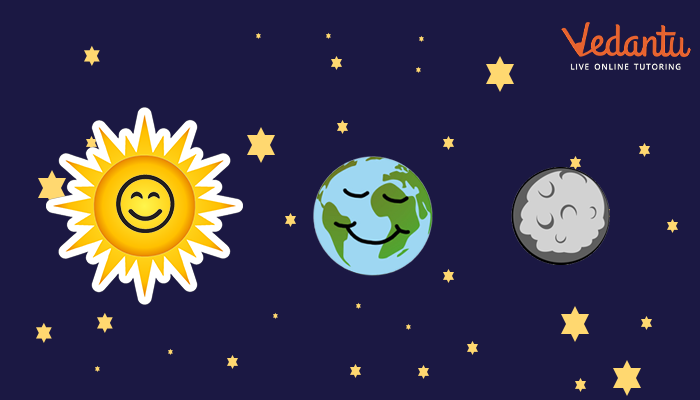
Sun, moon and Earth
Both the Earth and the Moon orbit around the Sun. Our Solar System revolves around the Sun, which is a star at the centre of it. The Sun is responsible for the light and heat you feel during the day. This energy keeps everything life on our planet alive.
Moon and Earth System
The Moon orbits the Earth on its axis in the same way as the Earth orbits the Sun. The Moon rotates on its axis in about 27 Earth days and revolves around the Earth in roughly twenty-nine and a half Earth days.
As the Moon's period of rotation (total time taken by the moon to complete one rotation) about its own axis and period of revolution (total time taken by the moon to complete one revolution) around the Earth are almost identical, the same side of the Moon always faces the Earth.
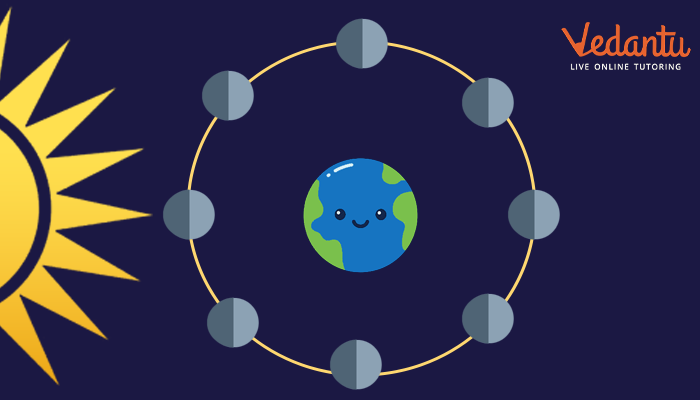
Revolution of Moon around the Earth
When viewing the Moon from Earth, changes in the Moon's brightness can be noticed as it rotates around the Earth, allowing more or less Sunlight to be seen. As a result, the Moon appears to alter form. The view of the Earth from the moon looks like a bright ball in space.
Earth Sun and Moon System
The Earth revolves around the Sun in an orbit and it completes one revolution around in 364 days. The rotation of the Earth on its own axis causes day and night on Earth. In 24 hours, the Earth completes one rotation.
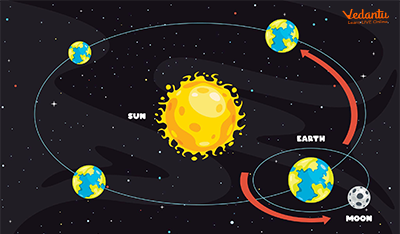
Revolution of Earth around the Sun and Revolution of Moon around the Earth
The formation of tides on Earth is mainly caused by the gravitational effects of the Sun and the Moon. The oceans of Earth nearest to the Moon expand outward, towards the Moon when the Moon circles Earth. This bulge represents the high tide. On the other side of the planet, another high tide occurs. Low tides occur in the intervals between high tides.
Eclipse and Its Types
An eclipse happens when one heavenly body blocks the passage of light, causing the light to be projected onto another heavenly body. Solar eclipses and lunar eclipses are the two forms of eclipses that may be seen from Earth. Due to the changing configurations of the Earth, the Sun, and the Moon, both eclipses occur.
Solar Eclipse: The Sun orbits the Earth, while the moon orbits the Earth. The moon occurs to pass between the Sun and the Earth on their separate courses. It then hides the Sun's light and casts a shadow on the Earth. People in the shadows are unable to see the Sun. A solar eclipse happens only on a new moon when the Sun, moon, and Earth line up.
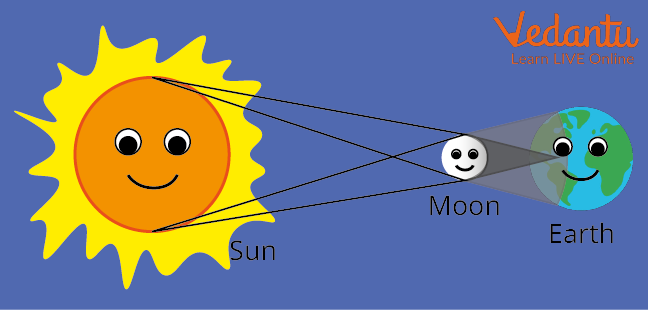
Solar Eclipse
Lunar Eclipse: When the Earth, the Sun, and the moon all line up and the Earth lies between the Sun and the moon, a lunar eclipse occurs. The moon is surrounded by a massive shadow created by the Earth. The moon's brightness fades to the point where it is scarcely visible.
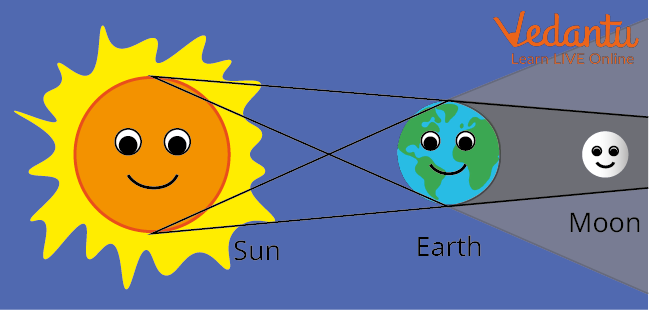
Lunar Eclipse
Solved Questions
1. What is the revolution of the Earth?
Ans: A revolution is a movement of the Earth around the Sun in a definite path. The Earth spins in an anticlockwise orientation, from west to east. In one year or 365.242 days, the Earth completes one rotation around the Sun.
2. Write some facts about the moon in solar system.
Ans: Following are the list of some facts about the moon in the solar system.
The Moon is the sole natural satellite of Earth and the solar system's fifth biggest moon.
The Moon's existence aids in the stabilisation of our planet's wobble and the regulation of our climate.
The Moon has an extremely thin atmosphere known as an exosphere.
Comet and asteroid impacts have cratered and pitted the Moon's surface.
3. What are the effects of the Earth's revolution?
Ans: As the Earth rotates around the Sun, its axis is inclined by 23.45 degrees from perpendicular to the plane of the ecliptic. Every 24 hours, the Earth turns on this axis. Since the axis is slanted, the impacts of the Earth's revolution change for various portions of the planet.
At certain periods of the year, certain locations are oriented toward or away from the Sun. The four seasons are caused by this tilting. Due to this tilting, the seasons in the Northern and Southern Hemispheres are opposite.
Fun Facts
Do you know there is water on the Moon?
The Earth is moved by the Moon, which causes the tides to rise and fall.
The Moon is receding from the Earth.
Summary
We have discussed the Earth Sun and Moon system and also the Earth and moon system. We have discussed “what is moon”, Earth’s revolution and rotation. The Earth takes 24 hours to complete one rotation and approximately 365 days to complete one revolution. Due to the revolution and tilt of Earth, the formation of different seasons takes place in the northern and southern hemispheres of the Earth.
Learning By Doing
Observe the night sky on a daily basis and see the different shapes of the moon and think about the reason behind the changing of the moon's shape. Then present these in your class and compare what your peers have written.
FAQs on Solar System - Earth, Moon and Sun
1. When the Moon passes between the Earth and the Sun, what happens?
When the moon passes between Earth and the Sun, it produces a shadow on Earth, which is known as a solar eclipse. Only during the new moon phase can a solar eclipse occur, when the moon passes directly between the Sun and the Earth, producing shadows on the planet's surface.
2. Is the moon orbiting the Sun?
The interaction between the Sun and the moon is more powerful than the interaction between the moon and the Earth. The moon revolves around the Earth and revolves around the Sun at the same time.
3. Is the moon rotating?
Every 27.322 days, the moon circles the Earth. The moon likewise takes around 27 days to spin once on its axis. As a result, the moon seems to be almost perfectly stationary to viewers on Earth, rather than spinning.









